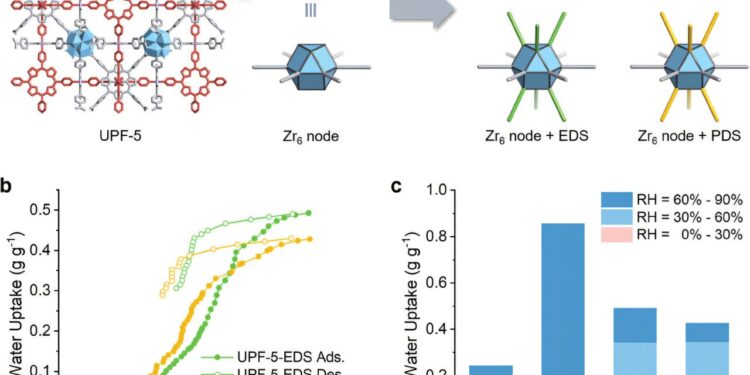Modification of coordination sites on the accessible Zr6 nodes in UPF-5. a)Zr6 node connectivity and simplification of node geometry within UPF-5, and introduction of EDS and PDS at accessible Zr6. Credit: Advanced functional materials (2024). DOI: 10.1002/adfm.202413200
The Burj Khalifa, the tallest building in the world, uses advanced construction techniques designed to withstand wind, seismic activity and its own weight. Among these techniques is the “meta-column system,” which plays a central role in strategically positioning large columns to resist lateral forces, thereby facilitating the construction of such an imposing structure.
What if these advanced architectural techniques could be applied to hardware design?
Metal-organic frameworks (MOFs) are porous materials formed by the combination of metal ions and organic ligands, giving rise to structures similar to building rebars. The design principle behind MOFs is very similar to architectural planning.
Professor Wonyoung Choe’s research team successfully synthesized a new MOF using a design strategy similar to “Mega Frame”, called “Merged-Net Strategy”. By incorporating large molecules into the MOF structure, in the same way that columns work in architectural design, they created “a structure within a structure,” thereby improving both porosity and structural stability. Their research is published in the journal Advanced functional materials.
This research represents a significant advance in addressing the persistent challenge of material stability in conventional MOFs. The newly developed MOF not only demonstrates exceptional water stability and structural integrity, but also exhibits superior water adsorption capacity and reusability compared to previously reported MOFs. Additionally, the team successfully demonstrated that the water adsorption properties of MOF can be precisely tuned by changing the active sites within its framework, thereby improving its versatility for various water sorption applications.
Junghye Lee, the first author of the study, said: “This new design method has the potential to surpass the performance of existing MOFs, significantly expanding their range of applications. »
Professor Wonyoung Choe remarked: “This research represents a breakthrough in precision design at the molecular level. By applying advanced architectural methods to molecular systems, we are opening new avenues in materials science. »
More information:
Junghye Lee et al, Programmable Fused Lattice Porphyrin Metal-Organic Frameworks for Water Absorption, Advanced functional materials (2024). DOI: 10.1002/adfm.202413200
Provided by Ulsan National Institute of Science and Technology
Quote: Leveraging Skyscraper Architecture: New Design Improves Porosity and Structural Stability of Metal-Organic Structures (2024, October 18) retrieved October 18, 2024 from
This document is subject to copyright. Apart from fair use for private study or research purposes, no part may be reproduced without written permission. The content is provided for informational purposes only.



